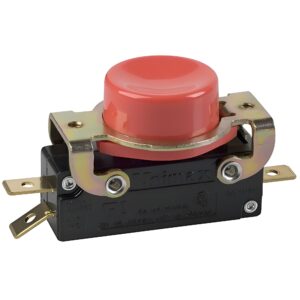What is a Snap Switch?
A snap switch is a type of mechanical switch designed for quick and precise operation. It features a spring-loaded mechanism that snaps into place when activated, ensuring a reliable connection or disconnection of an electrical circuit. This mechanism allows the switch to operate with speed and accuracy, making it a dependable choice for various applications. Snap switches are often used in industrial machines, household appliances, and automotive systems, where precision and reliability are crucial.

The design of snap switches focuses on reducing wear and tear. Their spring mechanism minimizes slow movements, which could lead to contact damage over time.
What is Another Name for a Snap Switch?
Snap switches are also commonly referred to as “quick-action switches.” This alternative name highlights their defining characteristic: the ability to switch between positions quickly and effectively. The rapid action of these switches sets them apart from slower manual switches, such as toggle or push-button types.
In technical contexts, they might also be labeled as “mechanical limit switches” when used to detect position or limit movement in industrial settings. The versatility of the snap switch has led to its widespread adoption under various names across different industries.
How Many Types of Snap Switches Are There?
Snap switches come in multiple types, tailored to different electrical and mechanical requirements. Below are the primary types:
1. Single-Pole, Single-Throw (SPST)
This is the simplest form of snap switch. It has one input and one output terminal, functioning as an on-off switch. It’s commonly used for straightforward tasks like controlling lights or small appliances.
2. Single-Pole, Double-Throw (SPDT)
This type has one input terminal and two output terminals. It allows the user to switch between two circuits. SPDT snap switches are popular in multi-functional devices or applications requiring alternate paths for current.
3. Double-Pole, Single-Throw (DPST)
DPST switches have two inputs and two outputs, controlling two circuits simultaneously. They are often used in systems requiring separate but simultaneous switching, such as dual power supplies or large appliances.
4. Double-Pole, Double-Throw (DPDT)
This type is more complex, offering two inputs and four output terminals. DPDT snap switches are used for reversing the direction of motors, switching between different power sources, or managing complex electrical systems.

Snap Switch vs. Toggle Switch
While both snap switches and toggle switches are used to control electrical circuits, their differences lie in their mechanisms and applications.
Mechanism
A snap switch uses a spring-loaded mechanism that quickly moves the contacts into position. This design provides a tactile click and ensures reliability over repeated use. Toggle switches, however, use a lever mechanism. While functional, the movement in toggle switches is slower and more manual compared to the quick action of a snap switch.
Applications
Snap switches are commonly found in safety-critical systems, automated machinery, and devices requiring precise and rapid switching. Toggle switches, on the other hand, are more suitable for manual operations, such as in home light switches or vehicle dashboards.
Precision
Snap switches often outlast toggle switches in demanding environments due to their robust design and reduced wear on contacts.
Advantage of a Snap Action Switch
- Quick Response
- High speed switching
- High repeatability
- Compact design
- Reduced Contact Wear
- Reliability
How to Switch Snap to Dark Mode?
This question applies to software interfaces rather than physical switches. If you’re using a software platform or app associated with the term “snap,” you can typically switch to dark mode by following these steps:
- Open the settings or preferences menu of the app.
- Look for “Appearance,” “Display,” or “Theme” settings.
- Select the “Dark Mode” or “Night Mode” option.
For hardware devices, “dark mode” settings might not apply unless the device has a digital interface. If this is about smart switches with app controls, refer to the app’s documentation for enabling dark mode.
What is a Snap Switch Used For?
Snap switches are incredibly versatile. Their quick-action design makes them suitable for a variety of applications, including:
Household Appliances
Devices like washing machines, microwaves, and refrigerators use snap switches for reliable on-off functions.
Industrial Machinery
In factories, snap switches are used to control conveyors, presses, and safety systems, where rapid and precise responses are crucial.

Automotive Systems
Snap switches are found in car doors, seatbelt sensors, and engine controls, providing quick feedback and operation.
Medical Equipment
Their precision and reliability make them ideal for critical applications in healthcare devices, ensuring patient safety.
Consumer Electronics
Snap switches are used in devices like printers, power tools, and gaming consoles for dependable operation.
Frequently Asked Questions (FAQs)
1. Are snap switches safe for outdoor use?
Yes, many snap switches are designed for outdoor use. Models with weatherproof housings can handle moisture, dust, and temperature changes, ensuring reliable performance in outdoor settings.
2. How do I maintain a snap switch?
Regularly inspect the switch for wear and tear, especially in high-use applications. Clean the contacts periodically to prevent dirt buildup. Avoid exposing the switch to extreme conditions unless it is specifically designed for such environments.
3. Can a snap switch handle high currents?
Yes, many snap switches are built to handle high currents and voltages. Always check the switch’s specifications to ensure it meets your system’s requirements.
4. Are snap switches easy to replace?
Replacing a snap switch is generally straightforward. Most designs are user-friendly, allowing for quick installation and removal. However, always follow the manufacturer’s guidelines to ensure safety.
5. What is the lifespan of a snap switch?
The lifespan depends on the quality of the switch and its usage. High-quality snap switches can last millions of cycles, making them a cost-effective choice for long-term use.




